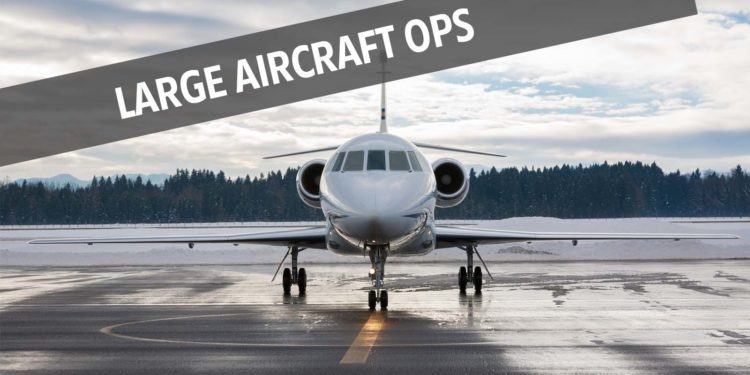Wide-body and Large General Aviation Aircraft Operating Considerations

Additional trip planning, permit, and day of flight considerations are recommended when operating wide-body or large general aviation (GA) aircraft. If you’re flying a Boeing 777 rather than a Gulfstream G550, for example, there are particular planning and logistical challenges to be aware of in order to ensure smooth operations to international destinations.
The following is an overview of what you need to know:
1. Definition of a wide-body aircraft
A traditional wide-body aircraft typically has a fuselage diameter of 5 – 6 meters (16 – 20 feet) with the largest wide-body equipment having a diameter of over 6 meters (20 feet). In the commercial airline world these are typically twin-aisle aircraft. Largest wide-body aircraft are the Boeing 747 and Airbus A380. Other wide-bodies, configured for GA, include the Boeing 777, Boeing 787, Boeing 767, Airbus A330/340, MD-11 and MD-11ER.
2. Large narrow-body aircraft
Larger narrow-body aircraft typically have fuselage diameters of 3 – 4 meters (10-13 feet) and include aircraft the size of, or larger than, a Gulfstream G650. BBJ variants of the Boeing 737, and ACJ versions of the A318/319, are examples of popular large narrow-body aircraft. Other large narrow-bodies in GA configuration include the Airbus A320-300, Boeing 757-200/300, Boeing 727 and Boeing 737-300/400/500/600/700/800/900ER.
3. Operational considerations for large aircraft
While some wide-body and large GA aircraft are fitted with their own air stairs, most require external stairs at destination. Additional ground support equipment (GSE) is often necessary to support these larger aircraft – including belt loaders, GPU, tow bar, and an external aircon unit. At certain locations, such as Mauritius, tow bars are a mandated requirement when requesting permits for large aircraft. As larger aircraft can uplift 5000 – 30000 gallons of fuel, uplift arrangements should always be made well in advance. Many large GA aircraft carry a flight mechanic with an enhanced fly-away spares kit. Flight crews are frequently augmented and crew count may be as high as 10-15 for a B777 GA operation.
4. Planning considerations
Additional permits may be needed for large aircraft operations. Aircraft overflying the U.S. may require a TSA waiver. At some locations, such as Barbados (TBPB), a landing permit is needed for charter aircraft with more than 20 seats. At Seoul Gimpo (RKSS) no aircraft with more than 20 passengers is permitted. At certain locations you’ll be required to operate to the main terminal, rather than the GA ramp. CIQ clearance may take place at the terminal if more than 15-20 crew and passengers are onboard. During large event periods at certain locations, it may be difficult to obtain parking for large or wide-body aircraft. Additionally, there are locations where runways and taxiways do not have the width or load-bearing capability to accommodate large or wide-body equipment.
5. Enhanced documentation requirements
Some Civil Aviation Authorities (CAAs) tend to view all wide-body and large aircraft as either charter or commercial. At certain locations CAA may want you to confirm, in writing and on company letterhead, that the flight is private non-revenue. You may need to provide an interior diagram to justify the assertion that this is a private GA operation.
6. Examples of documentation requirements
A. Israel
The following are documents required for all private non-revenue and charter operations to Israel:
- Certificate of registration
- Israel arrival application
B. China
The following are documents required for all private non-revenue flights with 30 seats or more to China:
- Copy of the aircraft cabin configuration diagram
- Other standard documents will also be required
The following are examples of additional documents required for large (ICAO Code “C” of above) aircraft:
- Certificate of airworthiness
- Noise certificate
- Radio license
C. South Africa
South Africa requires additional documentation for private non-revenue and charter large aircraft.
For private flights with more than eight passengers, documents must be provided with each permit application:
- A letter of declaration from the owner on company letterhead stating that the flight is operating as a private non-revenue flight
For charter flights with more than eight passengers, you must fill out a specific form and the foreign operator’s permit takes approximately seven days to obtain. The following are some examples of documents needed for large aircraft:
- Air operator’s certificate
- Radio license
- Maintenance release certificate
Barbados only requires a charter permit for large aircraft. Specifically, for business sized aircraft (ICAO Code B or smaller) no permit is needed. However, if commercial sized aircraft (ICAO Code C or larger) a permit is required.
7. In-flight catering requirements
Large and wide-body aircraft usually have larger galley configurations with additional heating elements and cooling capabilities. While high loader trucks are preferred for loading/unloading in-flight catering, these vehicles may not be readily available at smaller airports. At some locations you may need to load catering supplies via the L2 stairs. In certain cases local in-flight caterers will not be equipped to handle very large or specialty catering requests. You may need to resort to sourcing catering from local restaurants. In all cases, additional advance planning is recommended for large and wide-body catering.
Conclusion
When operating a wide-body or large GA aircraft it’s important to allow yourself additional pre-planning time to ensure that permits, aircraft parking, CIQ arrangements/Gate requirements, in-flight catering and GSE equipment is organized and ready at your destination. It’s best to bring your 3rd-party provider into the process early.
Questions?
If you have any questions about this article, contact me at eusebiotorresjr@univ-wea.com.



